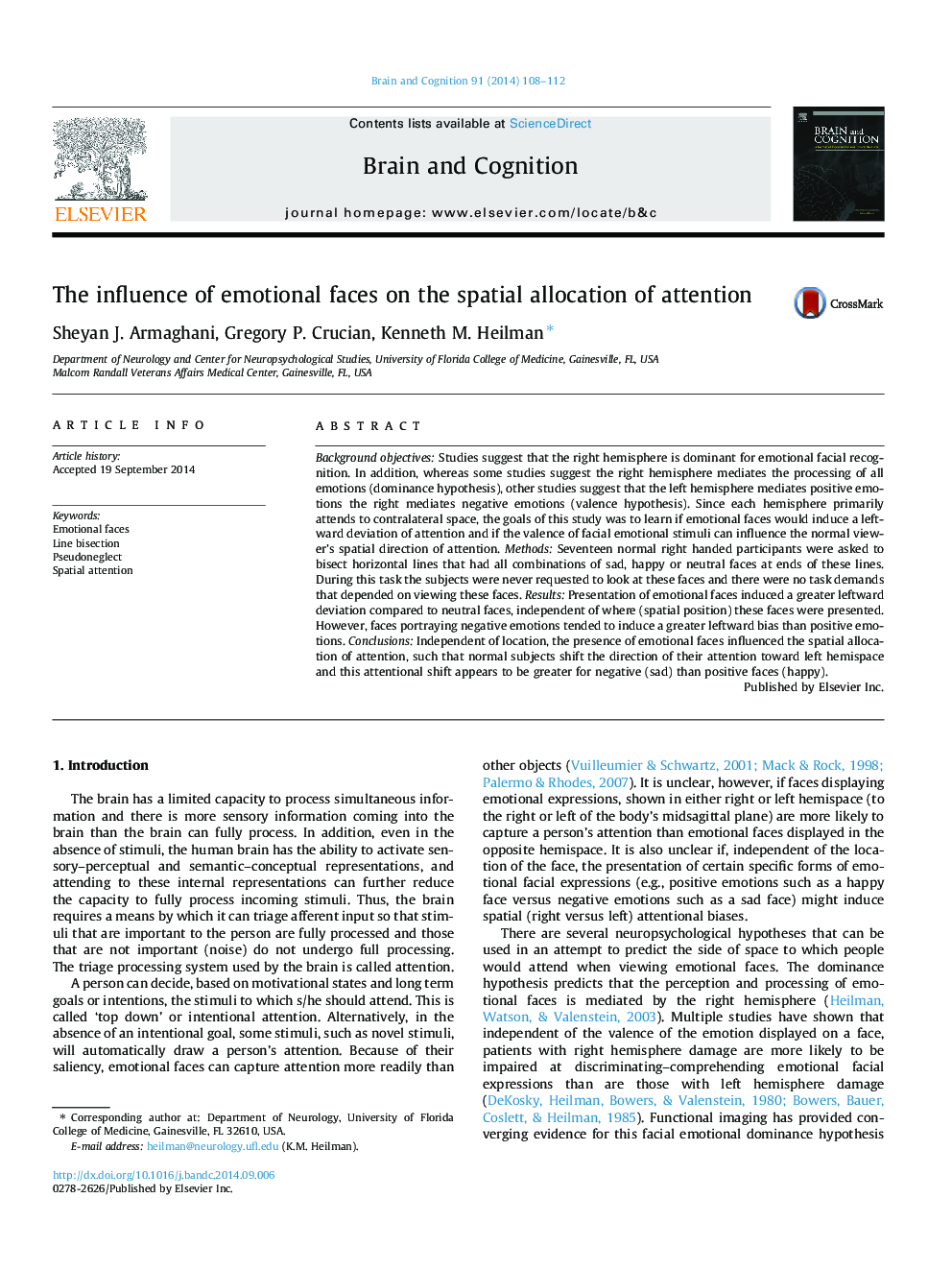| کد مقاله | کد نشریه | سال انتشار | مقاله انگلیسی | نسخه تمام متن |
|---|---|---|---|---|
| 7283210 | 1473980 | 2014 | 5 صفحه PDF | دانلود رایگان |
عنوان انگلیسی مقاله ISI
The influence of emotional faces on the spatial allocation of attention
ترجمه فارسی عنوان
تاثیر چهره های عاطفی بر تخصیص فضایی توجه
دانلود مقاله + سفارش ترجمه
دانلود مقاله ISI انگلیسی
رایگان برای ایرانیان
کلمات کلیدی
ترجمه چکیده
اهداف پیشین: مطالعات نشان می دهد که نیمکره راست برای شناخت عاطفی چهره غالب است. علاوه بر این، در حالی که برخی مطالعات نشان می دهد که نیمکره راست پردازش تمام احساسات (فرضیه سلطه) را متمایز می کند، مطالعات دیگر نشان می دهد که نیمکره چپ، میان احساسات مثبت و حق تعامل میان احساسات منفی (فرضیه والنسی) است. از آنجایی که هر نیمکره به طور عمده در فضای کنترلی حضور دارد، اهداف این مطالعه این بود که آیا چهره های احساسی موجب انحراف از سمت چپ توجه و در صورت تحریک محرک های احساسی صورت می شد که می توانست توجه جغرافیایی بیننده را تحت تاثیر قرار دهد. روشها: هشتاد نفر از اعضای عادی صحیح دست راست خواسته شدند خطوط افقی را که تمام ترکیبات غم انگیز، شاد و یا خنثی در انتهای این خطوط بود، تقسیم کنند. در طول این کار، افراد هرگز به دنبال این چهره ها نبودند و نیازی به وظیفه ای نبود که بر این چهره ها متکی بود. یافته ها: ارائه چهره های عاطفی موجب انحراف بیشتر سمت چپ نسبت به چهره های خنثی شده، مستقل از جایگاه (موقعیت فضایی) این چهره ها بود. با این حال، چهره های تصویربرداری از احساسات منفی تمایل به ایجاد تعصب چپ بیشتر نسبت به احساسات مثبت داشتند. نتیجه گیری: مستقل از موقعیت، حضور چهره های عاطفی تأکید بر تخصیص فضایی توجه را تحت تأثیر قرار داده است، به طوری که افراد طبیعی جهت جلب توجه خود را به سمت حاشیه سمت چپ جابه جایی می کنند و این تغییر توجه به نظر منفی (غم انگیز) .
موضوعات مرتبط
علوم زیستی و بیوفناوری
علم عصب شناسی
علوم اعصاب شناختی
چکیده انگلیسی
Background objectives: Studies suggest that the right hemisphere is dominant for emotional facial recognition. In addition, whereas some studies suggest the right hemisphere mediates the processing of all emotions (dominance hypothesis), other studies suggest that the left hemisphere mediates positive emotions the right mediates negative emotions (valence hypothesis). Since each hemisphere primarily attends to contralateral space, the goals of this study was to learn if emotional faces would induce a leftward deviation of attention and if the valence of facial emotional stimuli can influence the normal viewer's spatial direction of attention. Methods: Seventeen normal right handed participants were asked to bisect horizontal lines that had all combinations of sad, happy or neutral faces at ends of these lines. During this task the subjects were never requested to look at these faces and there were no task demands that depended on viewing these faces. Results: Presentation of emotional faces induced a greater leftward deviation compared to neutral faces, independent of where (spatial position) these faces were presented. However, faces portraying negative emotions tended to induce a greater leftward bias than positive emotions. Conclusions: Independent of location, the presence of emotional faces influenced the spatial allocation of attention, such that normal subjects shift the direction of their attention toward left hemispace and this attentional shift appears to be greater for negative (sad) than positive faces (happy).
ناشر
Database: Elsevier - ScienceDirect (ساینس دایرکت)
Journal: Brain and Cognition - Volume 91, November 2014, Pages 108-112
Journal: Brain and Cognition - Volume 91, November 2014, Pages 108-112
نویسندگان
Sheyan J. Armaghani, Gregory P. Crucian, Kenneth M. Heilman,
